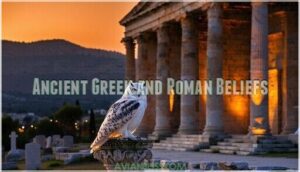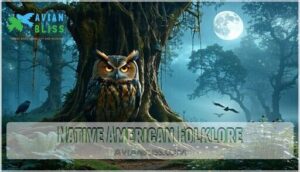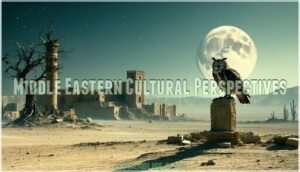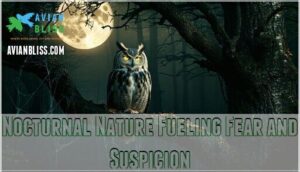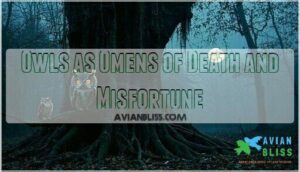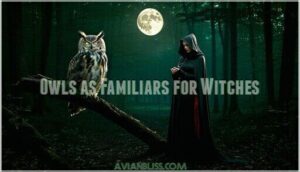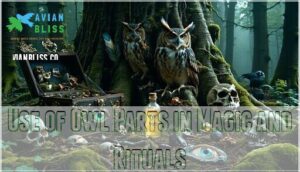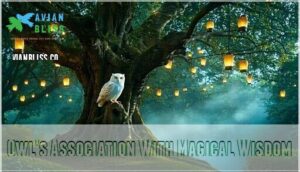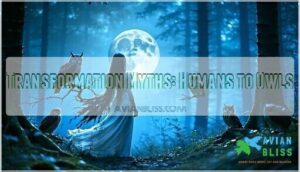This site is supported by our readers. We may earn a commission, at no cost to you, if you purchase through links.

Medieval Europe transformed owls into symbols of dark magic and witchcraft, while Native American folklore linked them to soul-stealing powers. Even their ability to rotate their heads 270 degrees added to their otherworldly appearance.
Notably, ancient Greeks actually revered owls as Athena’s sacred symbols of wisdom. However, centuries of superstition proved stronger than positive associations, embedding owls firmly in our collective fears.
Modern science reveals these traits as notable hunting adaptations rather than evil omens, yet cultural programming runs deep.
Table Of Contents
- Key Takeaways
- Origins of Owl’s Evil Associations in Mythology
- Nocturnal Nature Fueling Fear and Suspicion
- Owls as Omens of Death and Misfortune
- Witchcraft and Supernatural Connections With Owls
- Modern Perceptions of Owls and Evil Symbolism
- Frequently Asked Questions (FAQs)
- What does the owl symbolize evil?
- Why is an owl a bad omen?
- Why do owls have a bad reputation?
- What does the owl represent in the Bible?
- How do different owl species affect their perceived evilness?
- Are there cultures that view owls as purely benevolent?
- What role do owl physical characteristics play in superstitions?
- How has owl symbolism evolved in popular media?
- Do owls predict natural disasters or catastrophes?
- Why do some cultures fear owl feathers?
- Conclusion
Key Takeaways
- You’ll find that owls became linked with evil primarily through their nocturnal nature – ancient cultures couldn’t explain their silent flight, haunting calls, and glowing eyes, so they created supernatural explanations connecting these traits to death omens and dark magic.
- Medieval European folklore transformed owls into witch familiars and symbols of black magic, while Native American traditions viewed them as soul-stealing spirits who could carry people between worlds – these cultural beliefs spread and reinforced each other across civilizations.
- You’re dealing with centuries of cultural programming that turned natural hunting adaptations into supernatural fears – owls’ ability to rotate their heads 270 degrees, hunt silently, and see in darkness made them seem otherworldly to people who didn’t understand the science behind these behaviors.
- Modern education and popular culture are slowly shifting these perceptions, but you’ll still encounter deep-rooted superstitions because cultural beliefs about owls as harbingers of doom persist despite scientific evidence showing they’re simply efficient pest controllers with remarkable night vision abilities.
Origins of Owl’s Evil Associations in Mythology
You’ll find that owls’ dark reputation stems from ancient civilizations where their nocturnal habits and haunting calls sparked supernatural fears across multiple cultures.
From Greek associations with death omens to Native American beliefs about soul-stealing powers, these mysterious birds became woven into mythology as harbingers of doom and misfortune.
Ancient Greek and Roman Beliefs
Contrary to popular belief, ancient cultures didn’t view owls as evil omens. In Greek mythology, owls served as Athena’s symbol, representing wisdom and strategic warfare. The goddess worship surrounding Athena elevated these nocturnal birds to sacred status.
Roman gods followed suit – Minerva adopted similar owl legends. These ancient cultures celebrated owls’ mythological significance as divine messengers.
The evil associations with owls emerged much later, making early owls in mythology surprisingly positive symbols of knowledge and protection.
Medieval European Superstitions
Medieval Europe transformed owls into symbols of dark magic and evil omens. During the Middle Ages, witchcraft fears spread like wildfire, and owls became prime suspects as witch familiars.
Medieval folklore painted these birds as messengers of evil spirits, their night flights suggesting connections to black magic. The Church reinforced these superstition roots, linking owls to Satan himself.
Witch hunts targeted anyone associated with owls, cementing their reputation as harbingers of evil throughout European culture.
Native American Folklore
While European superstitions painted owls as omens, Native American cultures developed even deeper spiritual connections with these nocturnal creatures. You’ll find Tribal Owl Legends where Apache warriors feared owl calls meant death approached, while Cherokee shamans used Shamanic Owl Rituals for spiritual guidance.
Ancient Owl Stories describe owls as Native Spirit Guides carrying souls between worlds. These owl superstitions created lasting evil associations across diverse Native American cultures. The owl’s significance is also reflected in its role as a bad omen symbol in many Native American tribes.
Middle Eastern Cultural Perspectives
Moving beyond Native American traditions, Islamic symbolism and Arabic mythology tell a different story of Owl Symbolism. In Persian folklore and Ottoman legends, owls are cast as embodiments of evil spirits that roam deserts and abandoned places.
Mesopotamian culture viewed these creatures as harbingers of doom and death omens. Arabic traditions warn that "following the owl leads you to ruins," cementing their association with witchcraft and misfortune throughout the region.
The unique characteristics of owls, including their owl physiology traits, contribute to their mysterious and often feared reputation.
Chinese and Japanese Owl Symbolism
Throughout Asian mythology, you’ll discover that owl symbolism breaks the mold of Western evil associations. Unlike European cultural beliefs linking these nocturnal creatures to witchcraft, Chinese and Japanese traditions embrace owls as protective spirits and lucky charms.
- Chinese folklore views owls as guardians against fire and evil spirits
- Japanese Ainu people consider owl totems sacred messengers from divine realms
- Both cultures celebrate owls’ cultural significance as symbols of good fortune and wisdom
This stark contrast highlights how mythology shapes our understanding of these mysterious birds differently across cultures.
Nocturnal Nature Fueling Fear and Suspicion
You’ve probably noticed how owls seem to appear out of nowhere during nighttime walks, their silent flight and sudden presence creating an unsettling experience that has shaped human perceptions for centuries.
Their nocturnal behavior connects them to darkness and the unknown, making different cultures view these mysterious hunters with suspicion and fear.
Owl’s Silent Flight and Sudden Appearances
Nocturnal owls often exploit their Silent Hunting Tactics to become nature’s perfect predators. Their Feather Serrations eliminate flight noise, enabling Stealthy Movements that catch prey off-guard. You’ll never hear them coming until it’s too late.
These Surprise Attacks transform owls into harbingers of doom across cultures. Superstitions about evil owl apparitions stem from their ability to materialize silently from darkness.
Unlike bats’ Echolocation Abilities, owls rely purely on stealth, making their sudden presence genuinely unsettling for humans throughout history.
Eerie Vocalizations and Their Interpretations
Beyond their ghostly flight, owl sound patterns create an orchestra of fear that’s haunted cultures worldwide. You’ve likely heard these haunting calls echoing through darkness – each vocalization type carries its own sinister reputation. Different hooting variations signal everything from impending doom to messages from deceased relatives. These nocturnal calls penetrate silence like whispers from another dimension, making owls synonymous with evil across cultures.
- A bone-chilling screech that freezes blood in your veins
- Deep, rhythmic hooting that sounds like a funeral dirge
- Rapid-fire calls resembling ghostly laughter in the night
- Soft trills that seem to carry secrets from the spirit world
Nocturnal Hunting Habits
While their haunting calls unnerve many cultures, owls’ nocturnal behavior and hunting tactics create deeper fears. These carnivorous predators use acute hearing and night vision to locate prey in complete darkness.
Their nocturnal strategies involve silent flight patterns that allow surprise attacks on unsuspecting animals. Ancient peoples witnessed these nocturnal creatures swooping down without warning, associating their stealth with supernatural powers and evil omens.
Large, Glowing Eyes in Darkness
An owl’s glow effect transforms ordinary eye anatomy into something otherworldly. Their massive glowing eyes dominate their faces, creating an unsettling presence in darkness. Dark adaptation allows these nocturnal hunters perfect night vision, but limited eye movement forces dramatic head turns. This supernatural appearance has linked owls to evil and witchcraft across cultures:
An owl’s massive glowing eyes and supernatural head movements have linked these nocturnal hunters to evil and witchcraft across cultures
- Eyes appear to glow from reflected light
- Fixed position creates unblinking stare
- Oversized pupils capture maximum light
- Head rotation compensates for immobile eyes
Association With Darkness and The Unknown
Throughout history, you’ve feared what lurks in shadows. This Fear Psychology connects owls to evil through their Darkness Symbolism and Shadow Associations.
Midnight Legends portray these nocturnal creatures as Unknown Entities practicing witchcraft and black magic. Their Association with Evil stems from humanity’s primal terror of darkness, making owls perfect symbols for supernatural dread.
Owls as Omens of Death and Misfortune
You’ve probably heard the unsettling hoot of an owl at night and felt an unexplained chill run down your spine. Across cultures worldwide, these nocturnal encounters have long been interpreted as warnings of impending death or tragic misfortune within the community.
Owl Sightings Near Homes or Villages
When nocturnal hunters venture close to human settlements, they’ve historically triggered deep-seated fears across cultures. These home encounters transform owls from distant mysteries into immediate omens.
Rural folklore treats urban sightings as supernatural warnings, linking owl habitat intrusion with impending doom. Village legends describe owls perching near windows as death messengers, their evil association stemming from their nocturnal nature and witchcraft connections throughout history.
Interpretations of Different Owl Calls
Beyond mere sightings, different owl vocalizations carry distinct cultural meanings that fuel evil associations. In Polish folklore, owl calls near homes signal approaching death. Southern Indian traditions interpret one hoot as death, while two hoots bring success. The Apache believed specific call patterns warned of impending doom.
These auditory cues create fear because nocturnal hooting sounds pierce silent nights unexpectedly. Various cultures developed intricate systems linking owl vocalizations to supernatural messages, making these silent communications seem ominous rather than natural.
Owl’s Role in Death-related Folklore
Ancient civilizations viewed owls as powerful mortality symbols and afterlife messengers. You’ll find these birds woven into funeral rituals across cultures, where they’re seen as soul guides escorting the departed.
Apache traditions warned that owl dreams meant death approached. Cherokee leaders considered them harbingers of doom, capable of bringing sickness as punishment. European folklore painted owls as death omens, their appearances near homes signaling family tragedy.
These evil associations transformed owls into supernatural beings bridging our world with the unknown, cementing their role as bad luck’s winged ambassadors.
Cultural Beliefs About Owl’s Soul-stealing Powers
Many cultures view owls as soul-stealing creatures capable of capturing human spirits through dark magic. These evil omens represent harbingers of doom in folklore worldwide.
Native American traditions describe owls as spirit guides who ferry souls to the afterlife, while European beliefs link their mystic powers to witchcraft and owls practicing black magic.
Such evil associations persist across generations, reinforcing fears of supernatural predation.
Owl Appearances in Literature and Poetry
Throughout literature and poetry, owls appear as powerful Literary Symbols tied to evil and death. Shakespeare’s "Macbeth" uses owl shrieks to foreshadow murder, while Poe’s works employ Owl Symbolism as Poetic Metaphors for doom.
These Evil Associations stem from mythology and Folkloric Inspirations, where Cultural Allusions connect owls to Witchcraft and Owls in Mythic Storytelling traditions across cultures.
Witchcraft and Supernatural Connections With Owls
You’ll encounter centuries-old beliefs linking owls to magical practices across European, African, and Native American traditions. These connections stem from the owl’s nocturnal habits and mysterious appearance, which made them natural companions for witches and shamans seeking supernatural wisdom.
Owls as Familiars for Witches
Within medieval Europe’s supernatural beliefs, owls were among the most common animals suspected as familiars. These owl familiars served as spiritual companions to witches, bridging the physical and mystical worlds. Their nocturnal nature perfectly matched dark magic practices during late-night magic rituals.
Medieval folklore described witches forming supernatural connections with these birds:
- Owl familiars were believed to be incarnations of evil spirits helping witches cast spells
- These creatures carried messages between witches and supernatural realms
- Their silent flight made them perfect accomplices for secretive witchcraft symbols
Historical witch trials often used suspected owl associations as evidence against accused practitioners.
Use of Owl Parts in Magic and Rituals
Witches’ demand for owl parts created a deadly trade across cultures. Roman rituals used owl ashes for snakebites, while ancient Indians made eye broth for seizures. Cherokee shamans bathed children’s eyes with owl feather water. These practices fueled superstitions about Spellbound Owl Eyes and Dark Magic Potions.
| Culture | Owl Part Used | Magical Purpose |
|---|---|---|
| Roman | Owl feet ashes | Treat snakebites |
| Cherokee | Feather water | Eye ceremonies |
| Indian | Eye broth | Cure seizures |
| European | Hearts/organs | Love potion ingredients |
| Creek | Owl skins | Sacred amulets |
Owl Talon Charms and Ritualistic Owl Bones became prized possessions.
Owl’s Association With Magical Wisdom
Beyond ritual applications, owls held deeper Magical Insight in ancient cultures. Goddess Athena‘s sacred owl represented divine wisdom in Greek mythology, serving as a bridge between mortal and divine knowledge.
These Wisdom Symbols connected practitioners to Ancient Lore through Mystic Connections. Owl Symbolism transcended simple superstition, embodying Spiritual Guidance that shamans and mystics sought.
The spiritual meaning positioned owls as keepers of hidden truths and cosmic secrets.
Transformation Myths: Humans to Owls
Shapeshifting legends across cultures reveal humanity’s fascination with mythical transformations between humans and owls. European folklore tells of witches becoming owls to escape persecution, while Native American traditions speak of owl humanoids walking between worlds. These supernatural metamorphosis stories reflect our spiritual meaning-making around evil and transformation in mythology.
- Polish beliefs: Married women become owls after death
- Celtic legends: Druids transformed into owls for wisdom
- Slavic folklore: Witches shape-shift into owls at midnight
- Greek myths: Humans cursed to become owl creatures
- Norse tales: Warriors transformed into owl spirits
Owl’s Role in Shamanic Practices
Across five continents, shamans have woven owls into their spiritual practices for thousands of years. These nocturnal birds serve as bridges between worlds, helping practitioners access Ancient Wisdom that lies beyond ordinary perception.
- Owl Totems crafted from feathers and bones channel protective energies during healing ceremonies
- Shamanic Rituals incorporate owl calls to summon Spiritual Guides from the spirit domain
- Mystic Symbols featuring owl imagery mark sacred spaces and ceremonial tools
- Native American cultures view owls as messengers who carry souls between life and death
Despite their evil reputation in mythology, shamans understand owls differently. They’re not harbingers of doom but powerful allies in spiritual work. The bird’s ability to see in darkness mirrors a shaman’s gift for perceiving hidden truths.
Modern Perceptions of Owls and Evil Symbolism
You’ll notice that today’s world views owls quite differently than our ancestors did, as scientific understanding and popular culture have reshaped these ancient symbols of doom. While Harry Potter’s Hedwig and children’s books present owls as wise companions, many cultures still maintain their traditional beliefs about these nocturnal creatures carrying supernatural powers.
Owl Imagery in Popular Culture
Throughout history, owls have swooped from folklore into modern entertainment with dramatically shifting symbolism. Today’s Owl Imagery in Popular Culture transforms these nocturnal creatures from evil omens into Cultural Icons across Film Representations and Literary Motifs.
| Medium | Positive Portrayals | Negative Portrayals |
|---|---|---|
| Literature | Harry Potter’s Hedwig | Macbeth’s death omens |
| Animation | Winnie the Pooh’s Owl | Batman’s Court of Owls |
| Film | Guardians’ wise mentors | Horror movie harbingers |
| Video Games | Animal Crossing companions | Dark Souls enemies |
| Art | Children’s book illustrations | Gothic evil owl depictions |
Contemporary Artistic Depictions rarely connect owls with witches anymore, though horror genres still exploit their mysterious nature.
Changing Attitudes Towards Owl Symbolism
You’re witnessing a notable symbolic evolution as modern cultural shifts reshape how we view owls. Conservation impact and educational awareness have transformed public perception from ancient superstitions about evil owls to appreciation for these creatures.
The cultural significance of owls now emphasizes ecological importance over dark mythology. Owl symbolism continues evolving as people recognize their essential environmental role rather than fearing them as omens of evil.
Scientific Understanding Vs. Cultural Beliefs
Modern science reveals owls’ Scientific Facts—their nocturnal hunting abilities, silent flight, and ecological roles contradict evil owl myths. Yet Cultural Beliefs persist despite Rational Thinking.
This clash shows how Cultural Bias shapes our Symbolic Meaning of owls. Mythical Origins still influence Owl Superstitions, even as research debunks these fears.
Understanding symbolism versus biology helps separate fact from folklore about these exceptional birds.
Conservation Efforts and Public Education
Today’s conservation efforts are breaking through centuries of owl superstitions. Wildlife protection programs focus on habitat preservation while education outreach helps communities understand nocturnal behavior and silent flight as natural adaptations, not supernatural threats.
Conservation strategies combine scientific research with community engagement, transforming fear into fascination. These owl conservation initiatives prove that knowledge overcomes ancient myths, protecting these extraordinary predators for future generations.
Owls in Contemporary Art and Literature
Contemporary owls have spread their wings beyond ancient superstitions into modern creative expressions. You’ll find these nocturnal creatures reimagined across various artistic mediums, where Dark Symbolism meets fresh interpretations. Writers weave owls into Mythic Storytelling that challenges traditional evil owl folklore, while visual artists create Artistic Representations ranging from whimsical to haunting. Their Cultural Metaphors now explore themes of wisdom, mystery, and transformation rather than death omens.
- Literary Motifs: Owls appear as wise mentors in fantasy novels and mysterious observers in psychological thrillers.
- Visual Art: Contemporary painters blend traditional Owl Symbolism with modern aesthetics, creating thought-provoking pieces.
- Digital Media: Video games and animations feature owls as complex characters beyond simple superstitions.
- Performance Art: Theater and dance incorporate owl imagery to explore themes of knowledge, secrecy, and nocturnal wisdom.
Frequently Asked Questions (FAQs)
What does the owl symbolize evil?
Like shadows cast by moonlight, owls symbolize evil through European folklore linking them to death omens, witchcraft, and blood-sucking spirits.
You’ll find these nocturnal hunters representing darkness, supernatural threats, and mortality across various cultures throughout history.
Why is an owl a bad omen?
You’ll find owls considered bad omens across many cultures because their nocturnal nature and haunting calls connect them with death, darkness, and the supernatural domain in traditional folklore.
Why do owls have a bad reputation?
You’ll find owls carry bad reputations across cultures due to their nocturnal nature, eerie calls, and association with death omens in European folklore, witchcraft beliefs, and ancient superstitions linking them to darkness and misfortune.
What does the owl represent in the Bible?
You’ll find biblical owls represent desolation, judgment, and uncleanness. Apart from references to owls as unclean birds, the Bible features owls figuratively to symbolize tormenting loneliness, desolation, mourning, and judgment.
These nocturnal creatures symbolize spiritual isolation rather than worldly wisdom.
How do different owl species affect their perceived evilness?
Different owl species don’t inherently affect perceived evilness. **Cultural context shapes associations more than biology.
Barn owls’ ghostly appearance reinforced European death omens, while Great Horned owls‘ imposing size influenced Native American folklore differently.
Are there cultures that view owls as purely benevolent?
Surprisingly, you’ll discover Chinese and Japanese cultures view owls as purely benevolent symbols of luck and protection, warding off evil spirits and bringing prosperity to households.
What role do owl physical characteristics play in superstitions?
You’ll notice owls’ haunting nocturnal calls, silent flight, and piercing stare create an eerie presence. Their large eyes and head rotation ability make them seem otherworldly, fueling supernatural beliefs across cultures.
How has owl symbolism evolved in popular media?
You’ll see owl symbolism has shifted dramatically in popular media. Modern movies and TV shows now portray owls as wise guides and mystical messengers rather than harbingers of doom.
Do owls predict natural disasters or catastrophes?
Don’t count your chickens before they hatch—while folklore suggests owls can predict disasters, you shouldn’t rely on these claims.
Scientific evidence shows animals, including owls, can’t reliably forecast earthquakes or catastrophes.
Why do some cultures fear owl feathers?
You’ll find that many cultures fear owl feathers because they’re linked to death omens, witchcraft, and spiritual misfortune.
Traditional beliefs view these feathers as carrying dark supernatural powers that can harm families.
Conclusion
Ironically, you’ve spent centuries fearing creatures that are simply skilled pest controllers with impressive night vision. Understanding why owls are associated with evil reveals how cultural fears often override scientific facts.
Ancient societies created supernatural explanations for owls’ nocturnal behaviors, silent flight, and haunting calls. These myths spread across civilizations, linking owls to death, witchcraft, and dark magic.
Today’s research shows these "evil" traits are actually advanced hunting adaptations. While cultural programming runs deep, modern education gradually shifts perceptions toward appreciation rather than superstition.
- https://usbirdhistory.com/owls-mean-death/
- https://www.owlpages.com/owls/articles.php?a=62
- https://www.iflscience.com/owls-an-unnatural-history-71094
- https://moderngypsy.in/2021/11/22/symbolism-meaning-owls-philosophy-spirituality/
- https://georgiawildlife.com/out-my-backdoor-owls-don%E2%80%99t-deserve-their-bad-reputation

